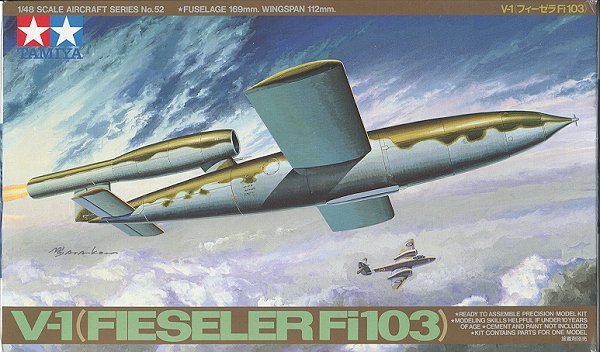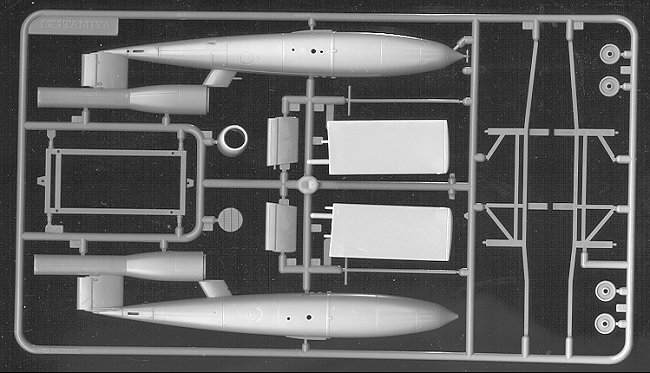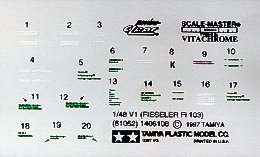
|
KIT: |
Tamiya 1/48 Fi-103 V-1 |
|
KIT # |
61052 |
|
PRICE: |
$13.00 |
|
DECALS: |
One aircraft |
|
REVIEW & |
|
|
NOTES: |
|

|
HISTORY |
The Fieseler Fi-103, more commonly called the V-1, was the world's first operational cruise missile. It was a very crude vehicle, but was also most effective in what it was designed to do. It was basically an aerodynamic bomb powered by a pulse jet. The pulse jet is a very simple engine that requires a minimum speed to operate. Once that minimum speed has been reached, fuel is injected into a chamber in spurts (thus the pulse part of the pulse-jet) and then lit, the controlled burning of that fuel provides thrust. It also gives the missile a very distinctive motor-boat sound while in flight.
Guidance is provided by a gyro and a mechanical devise that determines how far the missile goes before the fuel is shut off and the missile falls from the sky. The number of rotations of a small propeller on the nose of the missile is much of what determines how far the missile travels and this can be preset prior to launch.
Several thousand V-1s were launched during late 1944 and into 1945, most of them aimed at Britain or at Dutch ports. After the war, a number of them were captured and tested by the Allies. In the US, Ford reverse engineered the type and it went into service as the JB-2 Loon. The only way to tell the difference between a German and American version is that the US version has a more vertical forward engine pylon.
|
THE KIT |

Tamiya's kit is not the first V-1 in this scale. That particular honor goes to Hawk who did a V-1 / Baka bomb combo in the late 1960s. The Hawk version was pretty accurate and holds its own even today. However, the newer Tamiya kit is about as accurate as you can get, even down to the most elusive part of the kit, the shape of the nose.
 Packaged in an end-opening box that
is usually meant for military figures and small cannon, there are no
instructions included in the box. Those are printed on the back of the box.
There are 17parts on a single sprue, over half of them devoted to a trailer.
Painting the kit is quite simple and is basically RLM 71 over RLM 76 in any
pattern you should choose. As these were expendable missiles, no national
insignia was carried, though there is a nice sheet of data stencils included.
Packaged in an end-opening box that
is usually meant for military figures and small cannon, there are no
instructions included in the box. Those are printed on the back of the box.
There are 17parts on a single sprue, over half of them devoted to a trailer.
Painting the kit is quite simple and is basically RLM 71 over RLM 76 in any
pattern you should choose. As these were expendable missiles, no national
insignia was carried, though there is a nice sheet of data stencils included.
In reality, the V-1 was not that much of a precision machine and construction was not at very high standards. They were often dented and creased during transit and mounting for launch. Tamiya's kit is probably better shaped than just about any actual operational V-1!
|
CONCLUSIONS |
If there ever was a weekend kit, then this one would have to qualify. Made of few parts and a simple paint scheme, this is a kit that can be built by modelers of any skill level. Highly recommended.
If you would like your product reviewed fairly and quickly by a site that has thousands of visits a day, please contact me or see other details in the Note to Contributors.